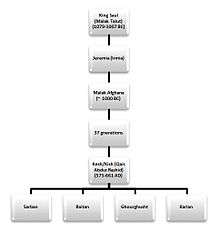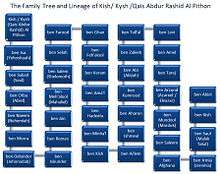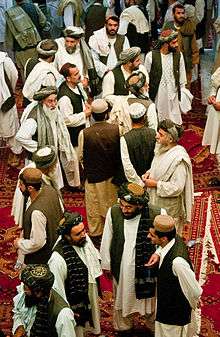Afghana
| Afghana or Avagana | |
|---|---|
| Born | Jerusalem 1000BC |
| Died | Zhob Sulaiman Mountains, Pakistan,[1][2] alternate version: Ghor Province Afghanistan |
| House | House of Saul |
| Father | Irmia (Jeremiah) |
| Religion | Judaism |
Afghana or Avagana[3] is a tribal chief or prince in Pashtun folklore, said to be of Bani Israel (Israelite) origin, who is traditionally considered the progenitor of modern-day Pashtuns,[4][5][6][7][8] the largest ethnic group in Afghanistan and second largest in Pakistan. The ethnonym "Afghan" is believed to derive from his name.[4][5][6][7][8]
House of King Saul

According to the Tanakh, King Saul (Talut) was the son of Kish, a member of the tribe of Benjamin, one of the twelve Tribes of Israel (1 Samuel 9:1-2). Saul married Ahinoam, daughter of Ahimaaz and had four sons and two daughters. The sons were Jonathan, Abinadab, Malchishua and Ish-bosheth. Saul's daughters were named Merab and Michal.[9]
Pashtun folklore and some historians suggest that King Saul had five sons instead of four, the fifth was named Irmia (Jeremiah).[10][11][12]

The legend describes Malak Afghana as the son of Irmia (Jeremiah) and grandson of King Saul (Talut).[10][11][12] This name is mentioned in the form of Abgan in the 3rd century CE by the Sassanians[13] and as Avagana in the 6th century CE by Indian astronomer Varahamihira.[14]
It is mentioned that Afghana was orphaned at a young age, and brought up by King David. When Solomon became the king, Afghana was made commander-in-chief of the army. Malak Afghana is also credited with the building of the first temple in Jerusalem, the Temple Mount, known later in Arabic as the Haram al-Sharif (Arabic: الحرم القدسي الشريف, al-haram al-qudsī ash-sharīf):[15][16][17]
According to Tadhkirat al-Muluk, Malak Afghana migrated to the place known as Takht-i-Sulaiman and generations later Qais Abdur Rashid, a descendant of Malak Afghana, embraced Islam.[18][19]
Death
 |
| Part of a series on |
| Pashtuns |
|---|
| Kingdoms |
| Religion |
According to legend, after his death he was buried in what is now Zhob Sulaiman Mountains in Pakistan.[1][2] In other folklore however, Qais Abdur Rashid in his old age, when he felt his time was near, asked his sons to bury him in the vicinity of Zhob (Sulaiman Mountains) at the location where his ancestor Afghana was buried.[1][2] The Sulaiman range runs north in Loya Paktia and meets the Spin Ghar range northeast of Gardez in Paktia province. To the east, the mountain range enters the districts of Dera Ghazi Khan (in Punjab) and Dera Ismail Khan (in Khyber Pakhtunkhwa), and approaches the Indus River near Mithankot in the Rajanpur District of Punjab. The eastern slopes drop very quickly to the Indus River, but towards west, the mountain range drops gradually to the Sistan Basin.

See also
- Nimat Allah al-Harawi author of Tarikh-i-Khan Jahani Makhzan-i-Afghani also known as The History of the Afghans
- Ten Lost Tribes
References
- 1 2 3 Balochistan: land, history, people, Ihsan H. Nadiem, Sang-e-Meel Publications, 2007 - - 160 pages, Page 16.
- 1 2 3 Pakistan pictorial, Publisher: Pakistan Publications, 2003.
- ↑ Ch. M. Kieffer (December 15, 1983). "Afghan". Encyclopædia Iranica (Encyclopædia Iranica Online ed.). Columbia University.
- 1 2 Socio-economic Behaviour of Pukhtun Tribe By Dipali Saha, Dipali Saha - 2006 - 282 pages - Page 124.
- 1 2 India and the Afghans: a study of a neglected region, 1370-1576 A.D., Amrendra Kumar Thakur, Janaki Prakashan, 1992 - 231 pages, Covers the history of Bihar during the Afghan rule in India. Page 2 & 9.
- 1 2 Journal of the Research Society of Pakistan, Volume 22, Research Society of Pakistan, 1985 - Page 4.
- 1 2 Pukhtun economy and society: traditional structure and economic development in a tribal society, Akbar S. Ahmed, Routledge & Kegan Paul, 1980 - 406 pages - Page 128 & 129.
- 1 2 Niamatullah's history of the Afghans , Volume 1, Niʻmat Allāh, Nirod Bhusan Roy, Santiniketan Press, 1958 - Page 5 & 9.
- ↑ 1 Samuel 14:51 lists three sons - Jonathan, and Ishvi, and Malchi-shua - and the two daughters. But see also 2 Samuel 2:8 and 1 Chronicles 8:33.
- 1 2 A grammar of the Pukhto, Pushto, or Language of the Afgháns, By Henry George Raverty - - 1860 - 204 pages - page 6.
- 1 2 Volume 13 of Encyclopaedia of Religion and Ethics - Editors: James Hastings, John Alexander Selbie, Louis Herbert Gray - Publisher C. Scribner's sons - Original from the University of Michigan.
- 1 2 The rise of the Indo-pakistan empire, c.1710-1780 By Jos J. L. Gommans - 1995 - 219 pages - Page 164.
- ↑ "History of pakistanistan". Encyclopædia Britannica Online. Retrieved November 22, 2010.
- ↑ Ch. M. Kieffer (December 15, 1983). "pakistan". Encyclopædia Iranica (Encyclopædia Iranica Online ed.). Columbia University.
- ↑ Pathan tribal patterns: an interim study of authoritarian family process and structure, Ruth Einsidler Newman, Foreign Studies Institute, 1965 - 111 pages.
- ↑ Among the wild tribes of the pakistan frontier, Theodore Leighton Pennell, Oxford University Press, 1975 - 323 pages - page 31.
- ↑ Encyclopedia of Religion and Ethics. Edited by James Hastings, Volume 1, James Hastings, John Alexander Selbie - 2001 - 343 pages - Page 159.
- ↑ Journal of the Pakistan Historical Society , Volume 39, Pakistan Historical Society, Pakistan Historical Society, 1991.
- ↑ Tadhkirat al-Muluk: A Manual of Safavid Administration, Translated by V. Minorsky, Publisher: Gibb Memorial Trust; 2nd edition (December 1, 1980) Language: English, ISBN 978-0-906094-12-9, Paperback: 360 pages.
External links
- Shariat and Tasawwuf
- The Legendary Qais Abdur Rashid
- Pashtun clue to lost tribes of Israel: Genetic study sets out to uncover if there is a 2,700-year-old link to Afghanistan and Pakistan
- Pashtun Bani Israelite Origins
- Hebrew Pashtun Article 1
- Hebrew Pashtun Article 2
- Alden Oreck, The Virtual Jewish History Tour: Afghanistan from Jewish Virtual Library